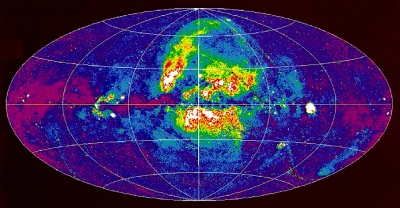X-ray
| Wavelength range | m | 10-9 - 10-11 |
| Frequency range | Hz | 3×1017 - 4×1019 |
| Energy range | eV | 103 - 105 |
 |
|
All sky image from ROSAT (RÖntgen SATellite) in the energy range 0.5 - 0.9 keV. |
ESA Missions
Exosat (1983-1986)
ESA's first X-ray satellite covered the energy range of 0.05 and 50 keV with its three instruments. The EXOSAT mission was approved in 1973, when the intention was to use lunar occultation to obtain precise positional information for the relatively small number of X-ray sources then known.
XMM-Newton
It is the biggest scientific satellite ever built in Europe to date and makes observations in the energy range 0.15 - 15 keV.
INTEGRAL
Next to a gamma-ray detector, Integral has a X-ray detector capable of observations in the 3 to 35 keV energy range.
Sources of X-ray radiation
- The Sun's corona: gas in this extended region above the upper atmosphere of the Sun reaches temperatures up into the 106 K range, making the gas radiate in the X-ray.
- Black holes: Gas falling into the black hole forms a disk in which the temperature of the gas increases inward. At the higher temperatures in the centre, the gas emits X-rays.
- Supernovae: the hot expelled gas and the electrons accelerated in the magnetic field of the remnant neutron star radiate X-rays.
- X-ray binary stars: When a companion star orbits a neutron star, material can be stripped from the companion and fall into the gravitational well of the neutron star and form an accretion disk. The material in the disk heats up and reaches temperatures upward of 106 K causing it to radiate in the X-ray part of the spectrum.
- Galaxy clusters: gas between the galaxy members of a galaxy cluster can reach high temperatures when it gains energy from the gravitational infall, resulting in X-ray emission from brehmsstralung.
Last Update: 1 September 2019
